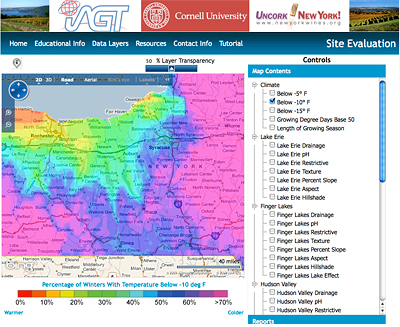Online tool helps N.Y. grape growers pick vineyard sites
By Ted Boscia

New York state can be a tricky place to plant a vineyard -- with its variable topography, deep lakes, assorted soil types and many microclimates.
In May Cornell researchers at the New York State Agricultural Experiment Station in Geneva, N.Y., simplified the process with the launch of a Web-based tool that helps beginning and established growers identify prime grape-growing locations.
The resource, funded by the New York Wine and Grape Foundation and available at http://www.nyvineyardsite.org, offers users macroscopic aerial views of the state's diverse grape-growing regions, as well as the ability to zoom in to a parcel of land to assess such site-specific factors as winter low temperatures, growing season length, soil chemistry and texture, drainage capabilities and slope of the land.
"We hope this site will help New Yorkers make better, more informed decisions about where to plant grapes and what types of grapes to plant," said Tim Martinson, Cornell senior viticulture extension associate, who developed the site with Alan Lakso, Cornell professor of horticultural sciences, and the NASA-funded Institute for the Application of Geospatial Technologies in Auburn, N.Y. "Grape growers need reliable, productive sites to make money over the 25-year life of a vineyard. Avoiding mistakes at the beginning will pay dividends for growers and the New York industry for years to come," Martinson added.
The Web site allows users to overlay two key data sets essential to choosing a vineyard location: the latest supercomputer climate models developed by Art DeGaetano, a climatologist at Cornell's Northeast Regional Climate Center, and detailed information on soil pH levels and other characteristics from a database maintained by the Natural Resources Conservation Service. With the click of a button, users can generate a written report that contains the relevant climate, soil and topography data needed to guide them in planting.
"This project acts as a strong example of how outside partners and Cornell faculty with expertise in viticulture, climatology and geographic information systems can collaborate to create a valuable tool that provides growers with a wealth of key information on a single, easy-to-access Web site," Lakso said.
With more than 33,000 acres of juice, wine and table grapes, New York ranks as the third-largest state for vineyard acreage. Winemaking in the state has become especially profitable -- nearly 100 of New York's 250 wineries have opened in the past five years.
More and more vintners are looking beyond the state's traditional grape-growing regions of the Finger Lakes, Long Island and along Lake Erie, especially with the introduction in recent years of cold-hardy hybrids capable of withstanding subzero temperatures.
Martinson said that the tool could steer producers away from locations where grapes would languish, as well as "match the right range of varieties for a particular location."
"Large areas of New York are either too cold in the winter, too prone to spring and fall frosts or simply do not accumulate enough heat or sunlight to consistently ripen grapes," he said. "Investing in vineyards in these areas doesn't make financial sense. On the other hand, this tool will help us and others advise growers about what varieties can be feasibly grown in a specific area."
Ted Boscia is a staff writer in the College of Agriculture and Life Sciences.
Media Contact
Get Cornell news delivered right to your inbox.
Subscribe